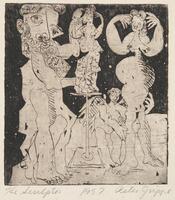21 UMMA Objects
21 UMMA Objects

Korean (Korean (culture or style))
Storage Jar on cut-out pedestal foot
500 – 699
Gift of Bruce and Inta Hasenkamp and Museum purchase made possible by Elder and Mrs. Sang-Yong Nam
2004/1.174
![The gray jar with a little long neck has a foot with rectangular perforations and is potted with fine silt-based clay. The relatively thin mouth is slightly everted. Three deep incisions encircle the midsection of the neck. The globular body is decorated with two incised line encircled the body. The foot whose bottom is rolled outward is a little high and wide.<br />
<br />
The long and splayed neck of this blue-gray, high-fired stoneware jar is encircled by two sets of ridges. The set on the upper section of the neck has two ridges, and the set on the lower section has one ridge. The rim is narrow and round. The inner surface of the neck shows rough, uneven surfaces resulting from wheel throwing. The body is widest at its middle. The vessel surface has been smoothed by paring on a wheel after attaching the low pedestal. The pedestal shows six rectangular perforations.
<p>[Korean Collection, University of Michigan Museum of Art (2017) p. 51]</p>
The gray jar with a little long neck has a foot with rectangular perforations and is potted with fine silt-based clay. The relatively thin mouth is slightly everted. Three deep incisions encircle the midsection of the neck. The globular body is decorated with two incised line encircled the body. The foot whose bottom is rolled outward is a little high and wide.<br />
<br />
The long and splayed neck of this blue-gray, high-fired stoneware jar is encircled by two sets of ridges. The set on the upper section of the neck has two ridges, and the set on the lower section has one ridge. The rim is narrow and round. The inner surface of the neck shows rough, uneven surfaces resulting from wheel throwing. The body is widest at its middle. The vessel surface has been smoothed by paring on a wheel after attaching the low pedestal. The pedestal shows six rectangular perforations.
<p>[Korean Collection, University of Michigan Museum of Art (2017) p. 51]</p>](/media/W1siZiIsIjIwMjIvMDkvMjQvMWNyMzV3bGVrZ19kZWZhdWx0LmpwZyJdLFsicCIsInRodW1iIiwiMjQweDIwMCJdXQ?sha=7b00061238459019)
Korean (Korean (culture or style))
Storage Jar on cut-out pedestal foot
400 – 599
Gift of Bruce and Inta Hasenkamp and Museum purchase made possible by Elder and Mrs. Sang-Yong Nam
2004/1.176
![Flared base with rounded food storage bowl on top. The base is cut with evenly spaced rectangular holes. The lid is incised with a repeating herringbone, or dotted design. The know on the lid is the shape of a Buddhist canopy, or chattra.<br />
<br />
This is a dark blue-gray, high-fired stoneware lidded stem cup. The lid is crowned by a pearl-shaped knob, while both the inner and outer surfaces of lid have traces related to the attachment of the knob to the lid. A v-shaped pattern of engraved dots, made using a sixtooth comb, surrounds the central knob. The cup’s flange slopes inwards and has a sharp edge. The cup body has a horizontal gallery that holds the lid in place. The stem is perforated by rectangular openings, below which is a sharply protruding circular raised band. Traces of rotation and water smoothing are visible on the body and stem of the cup.
<p>[Korean Collection, University of Michigan Museum of Art (2017) p. 59]</p>
Flared base with rounded food storage bowl on top. The base is cut with evenly spaced rectangular holes. The lid is incised with a repeating herringbone, or dotted design. The know on the lid is the shape of a Buddhist canopy, or chattra.<br />
<br />
This is a dark blue-gray, high-fired stoneware lidded stem cup. The lid is crowned by a pearl-shaped knob, while both the inner and outer surfaces of lid have traces related to the attachment of the knob to the lid. A v-shaped pattern of engraved dots, made using a sixtooth comb, surrounds the central knob. The cup’s flange slopes inwards and has a sharp edge. The cup body has a horizontal gallery that holds the lid in place. The stem is perforated by rectangular openings, below which is a sharply protruding circular raised band. Traces of rotation and water smoothing are visible on the body and stem of the cup.
<p>[Korean Collection, University of Michigan Museum of Art (2017) p. 59]</p>](/media/W1siZiIsIjIwMjIvMDkvMjQvOTRoajlpcWRqbV9kZWZhdWx0LmpwZyJdLFsicCIsInRodW1iIiwiMjQweDIwMCJdXQ?sha=27b6314c0d4219a2)
Korean (Korean (culture or style))
Pedestal Bowl with Cover
5th century
Gift of Bruce and Inta Hasenkamp and Museum purchase made possible by Elder and Mrs. Sang-Yong Nam
2004/1.169A&B
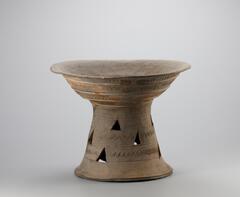
Korean (Korean (culture or style))
Large bowl or stand on high cut-out pedestal foot
5th century
Gift of Bruce and Inta Hasenkamp and Museum purchase made possible by Elder and Mrs. Sang-Yong Nam
2004/1.177
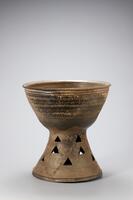
Korean (Korean (culture or style))
Large Pedestal Bowl or Stand
5th century
Gift of Bruce and Inta Hasenkamp and Museum purchase made possible by Elder and Mrs. Sang-Yong Nam
2004/1.179
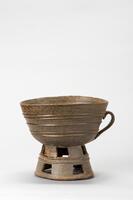
Korean (Korean (culture or style))
Pedestal Cup or bowl with handle, on cut-out pedestal foot
5th century
Gift of Bruce and Inta Hasenkamp and Museum purchase made possible by Elder and Mrs. Sang-Yong Nam
2004/1.180
![This vessel consists of a cup with an outward-flaring mouth supported on an inverted V-shaped pedestal foot. A single oval-shaped handle is attached to the underside of the cup. The pedestal foot is decorated with four vertical rectangular perforations. Immediately below this is a pair of thin horizontal ridges, which also encircle the body of the cup.<br />
<br />
This is a gray, high-fired stoneware stem cup. It is characterized by its shallow cup body and trumpet-shaped flared pedestal. A raised-band encircles the lower part of the pedestal, which is perforated by rectangular apertures in four places. A loop-shaped handle is attached to the lower part of the cup.
<p>[Korean Collection, University of Michigan Museum of Art (2017) p. 66]</p>
This vessel consists of a cup with an outward-flaring mouth supported on an inverted V-shaped pedestal foot. A single oval-shaped handle is attached to the underside of the cup. The pedestal foot is decorated with four vertical rectangular perforations. Immediately below this is a pair of thin horizontal ridges, which also encircle the body of the cup.<br />
<br />
This is a gray, high-fired stoneware stem cup. It is characterized by its shallow cup body and trumpet-shaped flared pedestal. A raised-band encircles the lower part of the pedestal, which is perforated by rectangular apertures in four places. A loop-shaped handle is attached to the lower part of the cup.
<p>[Korean Collection, University of Michigan Museum of Art (2017) p. 66]</p>](/media/W1siZiIsIjIwMjIvMDkvMjQvOHl0dW55ajA2NF9kZWZhdWx0LmpwZyJdLFsicCIsInRodW1iIiwiMjQweDIwMCJdXQ?sha=1e454ec5a8425f7e)
Korean (Korean (culture or style))
Cup with handle on cut-out pedestal
5th century
Gift of Bruce and Inta Hasenkamp and Museum purchase made possible by Elder and Mrs. Sang-Yong Nam
2004/1.181
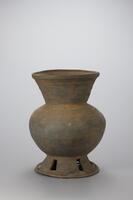
Korean (Korean (culture or style))
Large storage jar on cut-out pedestal foot
400 – 599
Gift of Bruce and Inta Hasenkamp and Museum purchase made possible by Elder and Mrs. Sang-Yong Nam
2004/1.185
![It has a little Flaring base with spherical food storage bowl on top. There are no holes in the base. The lid is attached with a knob-handle shaped like a button. There is no design on the lid but stained some part.<br />
<br />
This is a dark gray, high-fired stoneware lidded stem cup. The stem cup features a shallow bowl, a low pedestal, and a separate lid with a ring-shaped knob. The shape of the lid resembles the Korean vowel “ㅏ.” The flange of the cup slopes inwards and has a round edge, while the gallery supporting the lid protrudes slightly upwards. The pedestal is surrounded by several raised bands, and its bottom edge is rounded. The outer surface shows traces of the potter’s wheel and natural glaze in parts.
<p>[Korean Collection, University of Michigan Museum of Art (2017) p. 64]</p>
It has a little Flaring base with spherical food storage bowl on top. There are no holes in the base. The lid is attached with a knob-handle shaped like a button. There is no design on the lid but stained some part.<br />
<br />
This is a dark gray, high-fired stoneware lidded stem cup. The stem cup features a shallow bowl, a low pedestal, and a separate lid with a ring-shaped knob. The shape of the lid resembles the Korean vowel “ㅏ.” The flange of the cup slopes inwards and has a round edge, while the gallery supporting the lid protrudes slightly upwards. The pedestal is surrounded by several raised bands, and its bottom edge is rounded. The outer surface shows traces of the potter’s wheel and natural glaze in parts.
<p>[Korean Collection, University of Michigan Museum of Art (2017) p. 64]</p>](/media/W1siZiIsIjIwMjIvMDkvMjQvMXJhc2hlazR0Nl9kZWZhdWx0LmpwZyJdLFsicCIsInRodW1iIiwiMjQweDIwMCJdXQ?sha=dfc9ecad7d1ced69)
Korean (Korean (culture or style))
Covered Pedestal Bowl
7th century
Gift of Bruce and Inta Hasenkamp and Museum purchase made possible by Elder and Mrs. Sang-Yong Nam
2004/1.203A&B
American (American (North American))
Pedestal Card Table
1830 – 1850
Gift of Colonel and Mrs. Thomas M. Spaulding
1967/2.36
![The cover has a button-shaped knob at the top and is mostly plain. The mounted bowl has a outward-turned rim. This type of mounted bowl may be deated to sometime in the early 5th century.<br />
<br />
This is a blue-gray, high-fired stoneware lidded stem cup. The shape of the lid is similar to that of the Korean letter ‘ㅏ’ and is crowned with a ring-shaped knob. The cup’s flange slopes inwards and has a sharp edge, while the gallery that supports the lid protrudes slightly. The trumpet-shaped pedestal is perforated in four places by rectangular openings and has a slightly thick bottom edge.
<p>[Korean Collection, University of Michigan Museum of Art (2017) p. 61]</p>
The cover has a button-shaped knob at the top and is mostly plain. The mounted bowl has a outward-turned rim. This type of mounted bowl may be deated to sometime in the early 5th century.<br />
<br />
This is a blue-gray, high-fired stoneware lidded stem cup. The shape of the lid is similar to that of the Korean letter ‘ㅏ’ and is crowned with a ring-shaped knob. The cup’s flange slopes inwards and has a sharp edge, while the gallery that supports the lid protrudes slightly. The trumpet-shaped pedestal is perforated in four places by rectangular openings and has a slightly thick bottom edge.
<p>[Korean Collection, University of Michigan Museum of Art (2017) p. 61]</p>](/media/W1siZiIsIjIwMjIvMDUvMjUvcjBuYzhiaGI3X2RlZmF1bHQuanBnIl0sWyJwIiwidGh1bWIiLCIyNDB4MjAwIl1d?sha=012010f804da64cb)
Korean (Korean (culture or style))
Covered bowl on cut-out pedestal foot
5th century
Gift of Mr. and Mrs. Millard H. Pryor
1969/1.98A&B
Loading…
